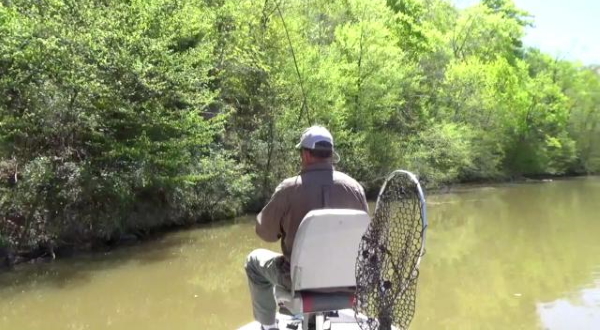
A Time to Make Memories
Story and photos by Sam Seamster ![]()
![]()
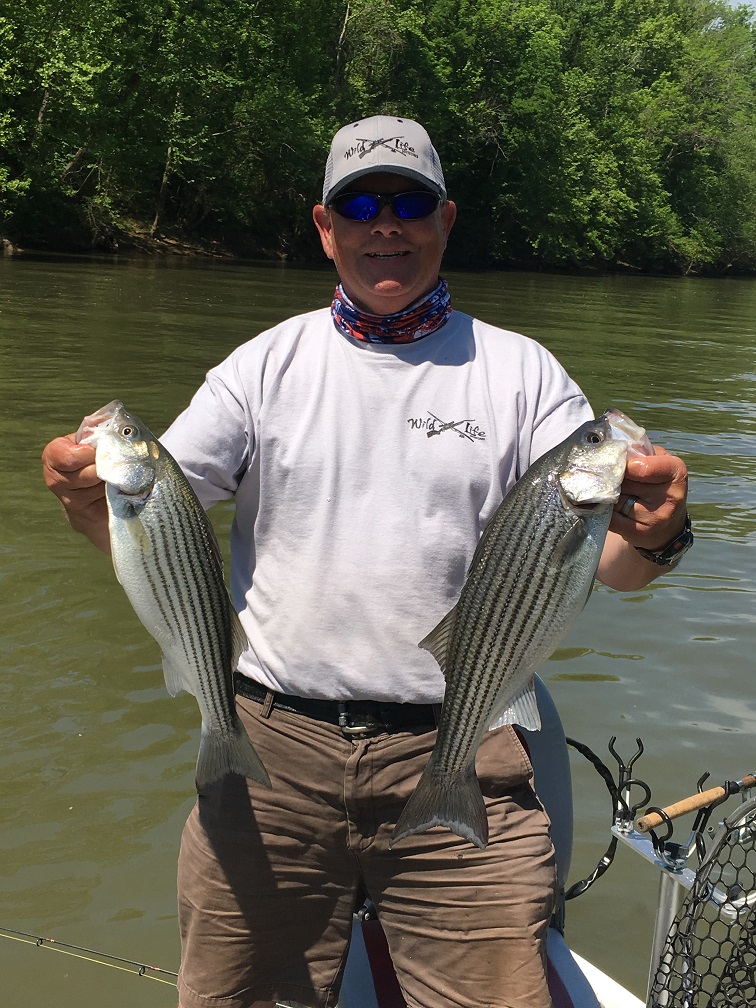 I was about seven when my dad and granddad took me along on one of their fishing trips. I can still remember how excited I was to go to a new pond they had found. As the old green aluminum boat slid through the tall grass into the edge of the water, I stood there, patiently waiting for my instructions to board. They loaded multiple rods, nets, tackle boxes and paddles into the boat, then Grandpa climbed slowly aboard, careful not to rock the boat. Then came my turn. My dad said, “Get on up in there and don’t step on any rods.” I quickly got to the middle seat and sat down facing my grandpa. With one foot in the boat, my dad gave a mighty push with the other, launching us out into the water. The boat glided quietly toward the opposite bank, which was lined with willow trees. Grandpa pointed to a good starting point.
I was about seven when my dad and granddad took me along on one of their fishing trips. I can still remember how excited I was to go to a new pond they had found. As the old green aluminum boat slid through the tall grass into the edge of the water, I stood there, patiently waiting for my instructions to board. They loaded multiple rods, nets, tackle boxes and paddles into the boat, then Grandpa climbed slowly aboard, careful not to rock the boat. Then came my turn. My dad said, “Get on up in there and don’t step on any rods.” I quickly got to the middle seat and sat down facing my grandpa. With one foot in the boat, my dad gave a mighty push with the other, launching us out into the water. The boat glided quietly toward the opposite bank, which was lined with willow trees. Grandpa pointed to a good starting point.
Grandpa set his paddle down quietly and picked up a rod and reel. Dad handed me an old black, open-faced spinning rod. He motioned for me to throw my line out into the middle of the pond where all the big fish were hanging out. I took this suggestion at face value, thinking that some huge bass was lurking in the depths and was getting ready to pounce on the plastic worm that was tied to the end of my line. It didn’t take long before I was bored with just casting and retrieving that old black Mister Twister worm, so I started twitching the rod from side to side, watching the tail of the plastic worm wiggle through the clear water. The twisting action was mesmerizing. I let it sink out of sight, then pulled it back up. All of a sudden, a large mouth bass came from underneath the boat, engulfing Mister Twister, then disappeared into the darkness.
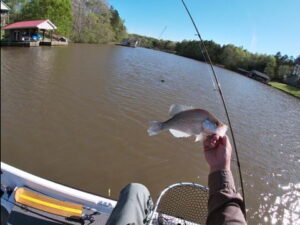 I quickly flipped over the bell of the spinning reel, allowing the bass to swim as the line peeled off quickly. “He’s got it, he’s got it,” I yelled. My dad calmly instructed me to flip the bell back over and start winding. “When you feel it get tight, set the hook hard!” He demonstrated with his own rod. I did as he instructed as I felt the line tighten. My heart beat wildly as I jerked the rod back. I could feel the fish fight before the line began to rise higher and higher. The bass broke the surface, leaping high into the air, shaking wildly back and forth, trying to free himself from the hook.
I quickly flipped over the bell of the spinning reel, allowing the bass to swim as the line peeled off quickly. “He’s got it, he’s got it,” I yelled. My dad calmly instructed me to flip the bell back over and start winding. “When you feel it get tight, set the hook hard!” He demonstrated with his own rod. I did as he instructed as I felt the line tighten. My heart beat wildly as I jerked the rod back. I could feel the fish fight before the line began to rise higher and higher. The bass broke the surface, leaping high into the air, shaking wildly back and forth, trying to free himself from the hook.
Back in the water, the fish pulled drag while I did nothing more than hold on. To this day, I hear the echoes of my dad and grandpa: “Hold him tight and give ’em some slack, don’t let that fish get away. You gonna let that fish whoop you?” I use some of those same phrases today, when fishing with others.
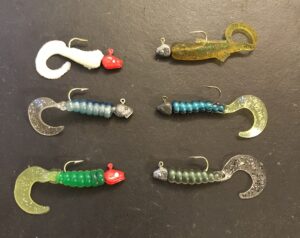 With the net, it didn’t take long for us to hoist that old largemouth bass up into our green aluminum boat. I was so excited that I had caught a huge fish. I still remember that day as if it were yesterday. I still get that same excited feeling in the pit of my stomach each time I start to back my boat down a boat ramp to go fishing.
With the net, it didn’t take long for us to hoist that old largemouth bass up into our green aluminum boat. I was so excited that I had caught a huge fish. I still remember that day as if it were yesterday. I still get that same excited feeling in the pit of my stomach each time I start to back my boat down a boat ramp to go fishing.
Now let’s talk about how you can make memories that you will share for the rest of your life. I will try to cover several bodies of water that you may want to fish. The fishing methods and water temperatures will be much the same on each body of water, so let’s get right to it.
The Dan River
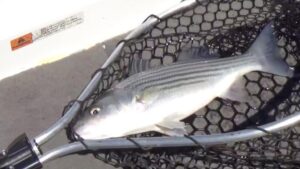 The Dan River has been a long-standing striper fishery since the early 1970s, when stripers migrate up the river for their annual spawning run. I can remember fishing there as far back as 1977 when the banks were lined with fishermen and john boats were buzzing up and down the river. Now, if you decide you want to fish on this river, you need to be mindful of the underwater obstructions and the many hazards that exist, and use extreme caution.
The Dan River has been a long-standing striper fishery since the early 1970s, when stripers migrate up the river for their annual spawning run. I can remember fishing there as far back as 1977 when the banks were lined with fishermen and john boats were buzzing up and down the river. Now, if you decide you want to fish on this river, you need to be mindful of the underwater obstructions and the many hazards that exist, and use extreme caution.
You have two choices to access this river: the Milton boating access on the North Carolina side or the Angler’s Park access on the Virginia side. The Dan will fluctuate during the spring with each passing rain storm so the time for good fishing on this river is usually during periods of stable weather. Starting in March, you can fish for white bass and white perch from the Milton boat ramp all the way up to Angler’s Park. These two species usually show up before the striper run. Look for an eddy or current break along the river, like a sandbar, creek mouth, or fallen tree that will provide some form of current break. That is where you will find these fish.
Once you have found a current break, you can anchor your boat within casting distance but not so close as to spook the fish. Casting into the still water and slowly retrieving a lure will provoke a swift strike from these fish.
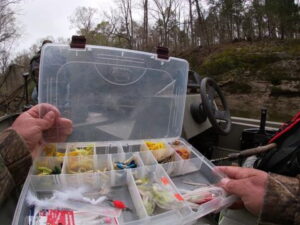 I like to fish with an inline spinner, like a Panther Martin, but because of the frequency of snags and line breaks, I will usually use a 1/8 ounce to 1/4 ounce gig head with a curly tailed grub (white, chartreuse, shad color, yellow) to catch fish. The grubs are much cheaper to lose than a $4.95 inline spinner. Stay with the lighter colors if the water is muddy or stained. Small crank baits will also entice a hungry fish. I like to use a medium to light action rod with a six-to-10 pound test line. Once the water temperature hits the 56-degree mark, you should see the largest concentration of fish available due to the spawning activity.
I like to fish with an inline spinner, like a Panther Martin, but because of the frequency of snags and line breaks, I will usually use a 1/8 ounce to 1/4 ounce gig head with a curly tailed grub (white, chartreuse, shad color, yellow) to catch fish. The grubs are much cheaper to lose than a $4.95 inline spinner. Stay with the lighter colors if the water is muddy or stained. Small crank baits will also entice a hungry fish. I like to use a medium to light action rod with a six-to-10 pound test line. Once the water temperature hits the 56-degree mark, you should see the largest concentration of fish available due to the spawning activity.
Then comes the long-awaited STRIPER RUN. By the end of March, you could see a few stripers showing up, depending on the water temperatures. Once water temperature reaches 60 degrees, you will see stripers staging in the river at different locations. Spawning activity will occur during a temperature range of 65 to 68 degrees. In April, if the weather is warm and stable, water temperature may rise more quickly and stripers may spawn towards the end of April. If water temperatures stay down, you will see stripers spawning during the month of May and as late as June. As a rule of thumb, by the end of May, they are usually done.
When fishing for stripers, use either live bait (shad or larger size minnows) or artificial bait. The use of a six- to seven-foot, medium heavy rod with 10 to 20 pound test line, with either bait caster or spinning reel is well suited for striper fishing, but it is mostly a personal choice. Plastic jerk baits, when fished with a 1/4 or 3/8 ounce jig head, make a good method.
While drifting along in the current, casting towards the bank and using a jerking motion while retrieving it without letting the bait sink to the bottom can be most productive. Once a stretch of river that has a higher concentration of fish is found, anchor the boat, cast across the current and use the same retrieval method. Many folks use crank baits or even rattle traps to catch stripers but any hard-sided lure that attracts a bass will entice a striper. Casting and retrieving cross current seem to be the preferred method among fishermen.
I always suggest that you never totally obligate yourself to just one method or lure while fishing.
Hyco Lake
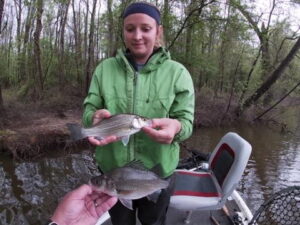 March at Hyco Lake is a good time to catch some really nice bass. Sow bass will sometimes make their way to the backs of certain coves to find water that is a few degrees warmer. They may be sitting in less than two feet of water. Look for coves that are receiving a wind flow on a sunny day. The warm surface water will stack at the back of the cove and provide water that is a few degrees warmer than other areas of the lake. Over the years, I have found Hyco to be unique when it comes to bass fishing. Depending on which section of the lake you are fishing, bass can be found in many places at the same time and at different depths. I have caught bass spawning in mid-March through mid-June. The more often you fish the lake, the more you will be able to track the fish migration.
March at Hyco Lake is a good time to catch some really nice bass. Sow bass will sometimes make their way to the backs of certain coves to find water that is a few degrees warmer. They may be sitting in less than two feet of water. Look for coves that are receiving a wind flow on a sunny day. The warm surface water will stack at the back of the cove and provide water that is a few degrees warmer than other areas of the lake. Over the years, I have found Hyco to be unique when it comes to bass fishing. Depending on which section of the lake you are fishing, bass can be found in many places at the same time and at different depths. I have caught bass spawning in mid-March through mid-June. The more often you fish the lake, the more you will be able to track the fish migration.
Crappie fishing will start to pick up in March and continue through June. I love to catch big spring crappies, and March through the first of April is a key time. Many of these big crappies will make their way to some sort of structure in shallow water and stage themselves on a wood or rock structure. By doing so, crappies can accomplish several things at one time. They can gain some heat transfer from the structure as well as use it to ambush or intercept a passing baitfish. I enjoy cruising along the upper stretches of the lake looking for isolated cover such as stumps, rocks, or the end of a blown-down tree. I then pitch a 1/6 ounce to 1/8 ounce curly tail jig into this type of cover. I did a video on my YouTube Channel about this method.
 Now, if you really want to make things interesting, and make sure that you are catching only the larger size crappie, tie a white or shad color Storm three-inch swimming minnow to your line. This swimming minnow has flat sides and can be skipped under tree limbs all the way back to the bank, and can be deadly on larger size crappie; plus, you will get the added bonus of catching a lot of bass. I have caught bass up to five pounds on this lure, while catching crappie at the same time.
Now, if you really want to make things interesting, and make sure that you are catching only the larger size crappie, tie a white or shad color Storm three-inch swimming minnow to your line. This swimming minnow has flat sides and can be skipped under tree limbs all the way back to the bank, and can be deadly on larger size crappie; plus, you will get the added bonus of catching a lot of bass. I have caught bass up to five pounds on this lure, while catching crappie at the same time.
Once water temps hit 52 to 55 degrees, all types of fishing will begin to pick up because the fish are starting to make their way to their spawning areas. As a side note: please remember that Hyco has a new fish, the Bodi bass, and this should provide more interesting fishing opportunities. The Bodi bass will not likely be harvestable size this spring, but you should see some of these fish being caught. Since Hyco Lake has a small population of white bass as well, make sure you identify your catch before you place them in a cooler. I am looking forward to seeing what this fishery will produce this year. I’ll keep you posted.
S.R. Farmer Lake
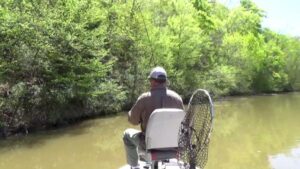 March marks the opening of S.R. Farmer Lake from its winter sleep. This Caswell County lake is closed from November through March each year. Farmer is a little different from most piedmont lakes and so is the fishing. Farmer Lake tends to be a few weeks behind most other lakes, with water temps rising more slowly, so this makes the fish move up a little later in the spring. I like to start fishing at Farmer Lake in late March.
March marks the opening of S.R. Farmer Lake from its winter sleep. This Caswell County lake is closed from November through March each year. Farmer is a little different from most piedmont lakes and so is the fishing. Farmer Lake tends to be a few weeks behind most other lakes, with water temps rising more slowly, so this makes the fish move up a little later in the spring. I like to start fishing at Farmer Lake in late March.
April seems to be one of the better months for the larger size bass. Bass can be caught on spinner bait, jig n pig, and rattle traps. I personally like to cast a black/blue jig tipped with a black crawfish; this is one of my favorite lures. Also on the list is white spinner bait with gold spinners.
Crappie at Farmer Lake tend to be on the smaller size. Unlike Hyco, which has an eight-inch size limit, Farmer Lake does not have a size limit and each angler is encouraged to keep all the crappie she catches. There are a lot of crappie in Farmer Lake, so it is my go-to-lake when I carry kids fishing. If you can find a beaver hut or any underwater brush pile, this is where you will find some good action.
I like to drive my bass boat right over the top of the beaver hut and drop the trolling motor to hold me in place. After the boat settles, take the rod in your hand let out about four feet of line. Hold the rod tip up in the air, then lower it, allowing the lure to slowly fall straight through the brush and then — boom, there he is! Swiftly set the hook and at the same time lift the crappie straight up and into the boat. Once a kid gets the hang of this method, you will not have an opportunity to fish because you will be too busy taking fish off his hook. Man, that’s fun!

















